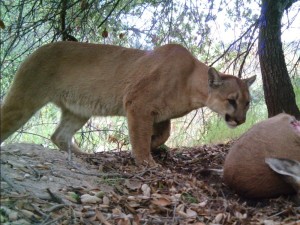Mountain lions
Mountain lions
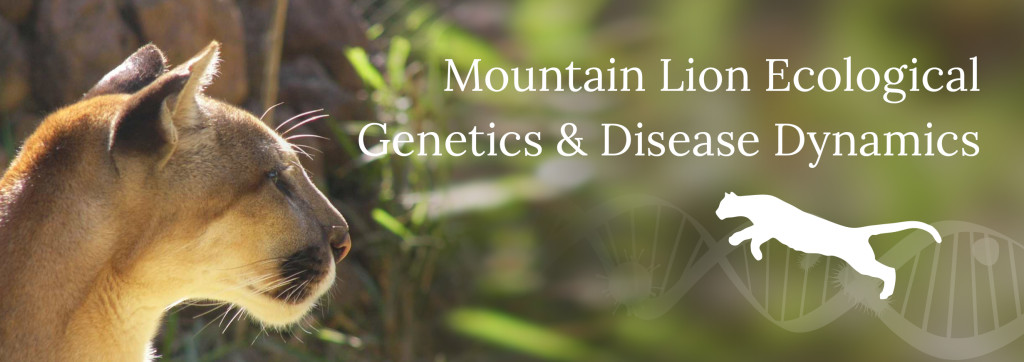
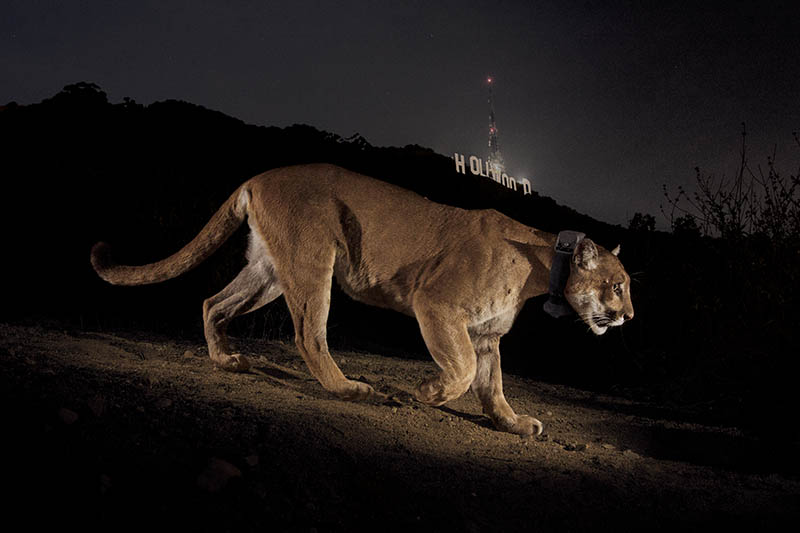
A hidden camera records Hollywood’s most reclusive star—this male cougar known as P-22 first seen in Griffith Park almost two years ago. A radio collar tracks his moves, but residents see scant signs of him. Photograph by Steve Winter
Lab researchers: Erick Gagne, Kyle Gustafson, Holly Ernest
Mountain life stories, pictures, and videos
Puma concolor – also known as the mountain lion, puma, cougar, catamount and the same species as the Florida panther.
We use genetic tools to study the ecology and health of mountain lion populations of the past, present, and future. Samples from mountain lions, including non-invasive fecal samples, will help us to determine kin relationships (mother-cub, aunt-nephew, grandparent-cub, etc), landscape features that effect mountain lion movement, and genetic viability of populations. In addition, we can develop predictive models of future trends for genetic diversity and transmission of infectious diseases among mountain lions. By learning more about this very special mammal we are able to inform management and conservation of mountain lions.
Population genetics
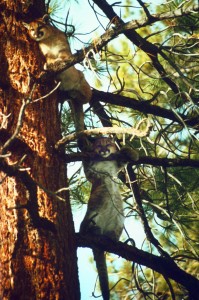 We use genetic markers to determine population structure, barriers to gene flow, and genetic diversity of mountain lions.
We use genetic markers to determine population structure, barriers to gene flow, and genetic diversity of mountain lions.
- Hematology of mountain lions (Puma concolor) in the Sierra Nevada, California, USA: effect of sex, season, or location? 2020. Vernon C. Bleich, Becky M. Pierce, Holly B. Ernest, Jeffrey T. Villepique. California Fish and Wildlife.
- Carnivore population structure across an urbanization gradient: a regional genetic analysis of bobcats in southern California. 2020. Julia G. Smith, Megan K. Jennings, Erin E. Boydston, Kevin R. Crooks, Holly B. Ernest, Seth P. D. Riley, Laurel E. K. Serieys, Shaelynn Sleater-Squires, Rebecca L. Lewison. Landscape Ecology.
- Extinction vortex dynamics of top predators isolated by urbanization. 2019, Journal is Ecological Applications. John F. Benson, Peter J. Mahoney, T. Winston Vickers, Jeff A. Sikich, Paul Beier, Seth P. D. Riley, Holly B. Ernest, Walter M. Boyce.
- Serum chemistry of wild, free-ranging mountain lions (Puma concolor) in the eastern Sierra Nevada, California, USA. 2019. Vernon C. Bleich, Becky M. Pierce, Jeffrey T. Villepique, and Holly B. Ernest. California Fish and Game 105(2):72-86.
- Genetic source–sink dynamics among naturally structured and anthropogenically fragmented puma populations. Kyle D. Gustafson, Roderick B. Gagne, T. Winston Vickers, Seth P.D. Riley, Christopher C. Wilmers, Vernon C. Bleich, Becky M. Pierce, Marc Kenyon, Tracy L. Drazenovich, Jeff A. Sikich, Walter M. Boyce, Holly B. Ernest. December 2018. Conservation Genetics
- Are all data types and connectivity models created equal? Validating common connectivity approaches with dispersal data. KA Zeller, MK Jennings, TW Vickers, HB Ernest, SA Cushman, WM Boyce. 2018 in press. Diversity & Distributions. Collaboration with University of Massachusetts, San Diego State University, US Forest Service Rocky Mountain Research Station, UC Davis, and others.
- A single migrant enhances the genetic diversity of an inbred puma population. 2017. Kyle Gustafson, Winston Vickers, Walter Boyce, Holly Ernest. Royal Society Open Science.
- Multi-level, multi-scale resource selection functions and resistance surfaces for conservation planning: Pumas as a case study. Zeller Kathy A, Vickers T Winston, Ernest Holly B, Boyce Walter M. 2017 PLoS One.
- Survival and Mortality of Pumas (Puma concolor) in a Fragmented, Urbanizing Landscape. T. Winston Vickers, DVM, MPVM; Jessica N. Sanchez; Christine K. Johnson; Scott A. Morrison; Randy Botta; Trish Smith; Brian S. Cohen; Patrick R. Huber; Holly B. Ernest; Walter M. Boyce. 2015. PLOS ONE.
- Fractured genetic connectivity threatens a southern California puma (Puma concolor) population. Ernest HB, T. Winston Vickers, Scott A. Morrison, Michael R. Buchalski, Walter M. Boyce. 2014. PLoS ONE 9(10): e107985. doi:10.1371/journal.pone.0107985.
- Individual behavior dominates the dynamics of a mountain lion population in a highly fragmented urban landscape. Seth P. D. Riley, John P. Pollinger, Laurel K. Serieys, Jeffrey A. Sikich, Lisa Dalbeck, Robert K. Wayne, and Holly B. Ernest. 2014. Current Biology. 24:1989–1994.
- Population Genetic Structure of Mountain Lions in California. Ernest H.B., V.C. Bleich, B.P. May, S.Stiver, S. Torres, W.M. Boyce. 2003. Conservation Genetics. 4(3): 353-366.
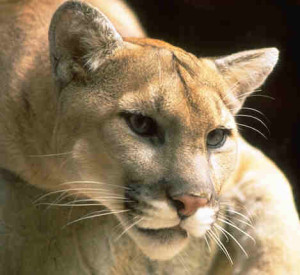 Development of new DNA tools
Development of new DNA tools
Using molecular techniques we have developed new and non-invasive techniques for studying the ecology and presence of mountain lions. In addition we conduct forensic work using molecular techniques to identify mountain lions associated with livestock predation and public safety incidents.
- Development of 21 microsatellite loci for puma (Puma concolor) ecology and forensics. Kurushima J., J. Well, J. Collins, H.B. Ernest. 2006. Molecular Ecology. 6:1260-1262.
- Fecal DNA analysis and risk assessment of mountain lion predation of bighorn sheep. Ernest H.B., E.S. Rubin, W.M. Boyce. 2002. . Journal of Wildlife Management 66(1) 75-85.
- Molecular tracking of mountain lions in the Yosemite Valley region in California: genetic analysis using microsatellites and fecal DNA. Ernest, H.B., M.C.T. Penedo, B.P. May, M. Syvanen, and W.M. Boyce. 2000. Molecular Ecology 9:433-441.
- DNA Identification of mountain lions involved in livestock predation and public safety incidents.H.B. Ernest, W.M. Boyce. 2000. Proceedings of the 19th Vertebrate Pest Conference. T. P. Salmon and A. C. Crabb, Eds. Published at the University of California, Davis. 290-29
Mountain lion disease dynamics
As part of a collaborative project funded by an NSF-EEID grant we will use landscape genomic approaches to evaluate the effects of landscape features and management practices on mountain lion population genetic structure. The information of mountain lion connectivity gained from the landscape genomics will then be used to inform network models of host connectivity, demographics, and disease dynamics. These models will be combined with models of viral transmission developed using contact dependent apathogenic viruses to develop models for pathogenic diseases. Our research team includes Sue VandeWoude (Colorado State University), Kevin Crooks (Colorado State University), Chris Funk (Colorado State University), Megan Craft (University of Minnesota), Scott Carver (University of Tasmania), Erick Gagne and Holly Ernest (University of Wyoming, Veterinary Sciences).
Mountain lion resources:
- 2019 video. Episode 5 on www.camountainlions.com/episodes features the genetic research Erick Gagne and Kyle Gustafson completed in our lab.
- Ernest H.B. DNA analysis for mountain lion conservation. Outdoor California. May-June. 61(3)16-19. Invited paper. 2000.
- Ernest H.B. DNA sampling and research techniques. Outdoor California. May-June. 61(3)20-21. Invited paper. 2000.
- Living with California Mountain Lions
- Mountain Lion Foundation
- UC Davis Karen C. Drayer Wildlife Health Center Mountain Lion web page
Check out stories about the research in:

